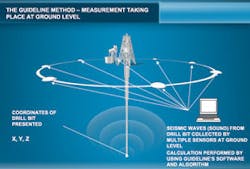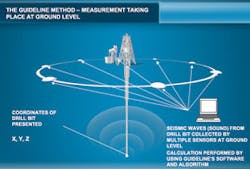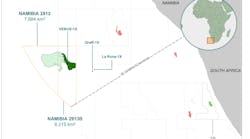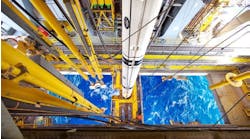Locating the position of the drill-bit in real time is a new technique from Guideline Oil Drilling Technology. The company aims to complete development of a land-based system this year, before adapting the system for offshore use.
Guideline’s technology employs seismic waves created by movement of the drill-bit to calculate its position. The system could be of major significance during directional drilling, when it is important to have accurate information on the location of the drill-bit, says CEO Peter Hjorth. Currently there is no method for doing this in real time, and often the process involves the time-consuming running of hardware down the well.
The company’s first target this year is to complete adaptation of the technology for mining and tunneling, followed by the oil and gas onshore application, in this case collaborating with a leading oil field services company.
The method involves monitoring the seismic waves generated by the drill-bit using an array of sensors placed on the ground. The distribution and number of sensors is governed by the well’s drill path, whether vertical or horizontal, and by the depth and length of the borehole.
Guideline is developing a method of locating the position of the drill-bit in real time using seismic waves.
Seismic data is delivered to a central collection point, and the x, y and z coordinates for the drill-bit are calculated within a few seconds using an algorithm. The background for this method comes from geological and seismological experience in Sweden, Hjorth says. Key elements such as the method of positioning the drill-bit in real time have already been patented and approved in Sweden and the US, and approvals are pending elsewhere in Europe, Canada and Japan.
Guideline believes that accuracy equivalent to current non-real time measurement methods is attainable. The results of the system are verified using established positioning methods.
Development of the algorithm is at the heart of the system. But the collection of the seismic data also presents challenges.
Compared with the percussion drilling used in the mining industry, the rotating bit employed in oil and gas drilling creates a weaker signal. This weakness is accentuated when drilling enters softer formations. Part of the development effort has therefore focused on identifying the best kind of sensor to use and the means of amplifying the signal.
Traveling speed of the seismic waves also varies according to the nature of the formation. Early readings are therefore taken when the drill-bit enters a new formation as a basis for calculating the pace at which the drill-bit passes through this formation.
Directional drilling, which has grown rapidly in recent years, offers an attractive market for this technology. This year some 20,000 directional wells are forecast to be drilled, generating a global spend of $5 billion on directional drilling services alone. The benefits of the technique are clear for land-based directional drilling, Hjorth claims. By conducting all measurements from ground level, drilling could be done faster, leading to significant cost savings, as no equipment needs to be run downhole.
For offshore application, the same basic method would be used, but with some adaptation. The sensors will be placed on the seabed, as is already the case with some kinds of subsurface surveying. These sensors will likely be linked by cable to collection points at the surface, with the data then transmitted by wireless method to the drilling rig.•
For more information, contact Peter Hjorth, Guideline Oil Drilling Technology. Tel: +46-733 25 75 03, [email protected].




